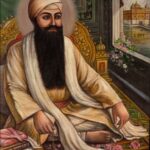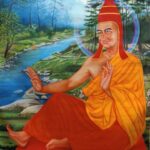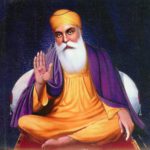Some figures like the Sikh Gurus hold centre-stage, others fade into the background while playing a central role. The next article in our Continuing Series on Sikh Personalities is one who is not often given his due, but deserves fame for his part in explicating Dharma.
Rather than by some stately title, he known merely by this simple moniker: Bhai Gurdas.
Background
Bhai Gurdaas like so many significant Sikh figures, was born at Goindwal, Amritsar District, Punjab. The course of his life would span five Gurus, and he would play a key role during the lives of four of them. He was a sish, a sevak, and a smith of words all at the same time.
Born in 1551 CE, this nephew of Guru Amar Das would ascend to tremendous heights of scholarship. He would grow to become a scholar of Sanskrit, Punjabi, Persian, and Hindi (Braj Bhaasha). [2, 71]
“Bhai is a ‘high title among the Sikhs… which continued to be conferred by the Gurus, till Guru Gobind Singh’s time, upon the most promi-nent Sikhs, such as Bhai Buddha, Bhai Gurdas…'” [1, 13]
Guru Amar Daas’ youngest brother was Ishar Daas had a son. With the commitment of a new convert to the faith, the parents of this child named him Gur Daas (‘bondsman of the Guru’). He would be the first child born in the family after it adopted Sikhi. However, few details beyond this are known about Bhai Gurdaas’ early childhood. Regardless, he would be a contemporary of 5 Gurus and 8 Emperors, playing a pivotal role in both the spiritual and political aspects of Sikh Dharma‘s development. It was a longevity exceeded only by Bhai Budha. Interestingly, it was he who was credited with first teaching the young Gurdaas the characters of the Gurmukhi script. [1, 23]
Goindwal was a prominent fulcrum of early Sikhism. It owed its origins to a man named Goinda Marwaha, who founded the eponymous town in 1532 CE. He gave favourable terms of settlement to the Third Guru’s family (the clan of Baba Tej Bhan of Basarke). This would be the cause for the rise in the settlement’s fortunes, as attested to by Bhai Gurdaas in stanza 46 of his first Vaar:
“He (i.e., Guru Amar Das), caused Goindwal to be populated…” [1, 21]
If Kartarpur ( in Sialkot district) was founded by Guru Nanak, and Khadur was made prominent by Guru Angad, then Guru Amar Daas was responsible for the centrality of Goindwal. Gurus and Bhais alike would be born there. There was free boarding and lodging, kirtan, sangat & pangat without caste discrimination, and volunteer social service.
“They felt liberated from the rigours of castes, rituals, superstitions and all types of fears.” [1, 21]
Unfortunately, much is not known about the family life of Bhai Gurdaas. But what has come down to us are his vast contributions to the Sikh religion and society. First and foremost was his anointment by Guru Arjan Dev to assist him in compiling the Adi Granth.
Adi Granth
“After its completion in August 1604 it was…well-bound. All the hymns collected and compiled contained original composition of the five Gurus, Bhagats, saints, bards and four Gursikhs. The Bani of all contributors was in the praise of God written in verse in 30 Ragas which would be put to music.” [2, 72]
As recounted in the preceding article, Guru Arjan Dev faced a dilemma in acquiring the Mohan Pothi from his uncle. After numerous emissaries and entreaties, this was finally achieved. However, its compilation and reorganisation was another matter altogether.
“Several Hindu and Muslim saints like Peelu, Jahna Chhajju, Shah Hussain, requested the Guru to include their hymns in the Granth Sahib. The Guru having examined their compositions, rejected them because those were not identical with the mission of Guru Nanak. However, the Guru wished to include Bhai Gurdas’s hymns.” [2, 72]
Ever humble, the Gursikh demurred stating he did not feel worthy of having his work included in so sacred a text. Nevertheless, Bhai Gurdaas would become responsible for studying, copying, and organising the Mohan Pothi under the guidance of the Fifth Guru. The new copy would be called “Pothi Sahib”, and eventually renamed as Adi Granth. It would take two years, countless hours, and immeasurable dedication to achieve this work by pen and ink.
“The Holy Book was completed in August 1604 and installed in Har Mandar ceremoniously. It was placed at a high pedestal while the Guru and the entire congregation bowed before it.” [2, 72]
This was a tremendous task, which naturally led to a guiding document to help navigate through Ocean of the Granth. But if Granth was the samudra, the result of this Gursikh’s effort was a figurative saagar (lake) known as the Vaaran of Bhai Gurdas.
The Vaaran

The Vaaran of Bhai Gurdaas ji is described as the “Key to the Granth”. If Guru Arjan was the ‘Compiler of Adi Granth’, then Bhai Gurdaas was the Chief Scribe and Elucidator of it. Following the achievement of this monumental task, this Gursikh (sometimes also described as Gurmukh), then took it upon himself to pen a work that would provide guidance to those attempting to fathom the profundity of Granth. He credited Guru Arjan Dev with instructing him to compose this work.
“Guru Arjan ordered me
To compose 40 Vars
So that peace may descend upon me.” [1, 39]
Often titled Vaaran Gian Ratnavali, true to the moniker, these Vaars are literaly “Gems of Knowledge”. It is classified as a Janam Saakhi (Life Story) of Guru Naanak Dev ji. The oldest manuscript dates to 1782 CE. It is written predominantly in Punjabi and Braji . It is believed to contained as many as 40 vaars. [1, 35]
Many of these Vaars contain tales from the Hindu Puraanas. The 10th Vaar, for example, tells of the story of Prince Dhru (Dhruva), and his encounter with Narada Mahamuni. Other stories from Raajarishi Janaka to Sri Krishna are also contained in the collective work. [1, 37] Perhaps the most notable lesson from his work is the following:
“God’s Name is the real deliverer from suffering; Ajamal and Ganika got deliverance by repeating the same Name.” [1, 37]
Of particular note was his appreciation for the difficult position the young Guru Hargobind was in, following the passing of his father. The Bhai defends the Sixth Guru by poetically telling of the imposing burden he bore. Despite the obstacles and the odds, Sikhs remained devoted to him. [4, 65]
“Bhai Gurdas had used an apt metaphor for the change introduced by Guru Hargobind in the beginning of the seventeenth century: the orchard of the Sikh faith needed the thorny hedge of armed men for its protection.” [4, 80]
Emissary
“In practical life, Bhai Gurdas was a paragon of humility, loyalty and sincerity” [1, 32]
Throughout the course of his life, Bhai Gurdaas would play the role of emissary. His most famous diplomatic service was rendered at the mughal court. Akbar demanded an explanation for the alleged blasphemy the qazis of the court said was contained in the Granth. Along with Bhai Budha, Bhai Gurdaas took the composition before him and read out sections. After repeated quizzing, the potentate was satisfied, and offered 51 gold mohars. He then presented Bhai Gurdaas and Bhai Budha with robes of honour. [2, 74]
During the Guruships of the Fifth and Sixth Gurus, Bhai Gurdaas would prove to be instrumental in containing the adharmic and divisive role of Baba Prithi Chand (Pirthia).
From filtering out the apocryphal shaloks of Meharban to diplomatically defending the Gaddi of the young Guru Hargobind, this Gursikh would be instrumental in a subordinate capacity, of shaping the role and rise of the Sikh Panth.
“It speaks volumes fro the loyalty, adjustability and utility of the Bhai that his services were in eager demand by all the Gurus, beginning with Guru Amar Das, the third Guru and ending with Guru Hargobind, the sixth Guru”. [2, 18]
Achievements

“The Bhai converted all such challenges into opportunities.” [1, 18]
It is rare for someone other than a Guru to play so significant a role in the development of Sikhi. If Baba Banda Bahadur facilitated its political rise, then Bhai Gurdaas facilitated its literary rise. He had a singularly splendid scholarly constribution.
It was as though from birth itself he were being prepared for his role as a scholar-diplomat. Trusted associate of four Gurus, he would be valued for his sharp mind, loyalty, and literary accomplishment.
“Phrases and lines flashed through his mind in quick succession and in such a pithy and polished form that these could easily pass as centuries-old sayings and proverbs…” [1, 10]
The Vaaran remains his most original accomplishment. A “Vaar is a form of heoric poetry about which it has been claimed that it owes its origin solely to Punjabi genius as the same has not yet been discovered as such in the old and medieval literatures of the areas adjoining Greater Punjab.” [1, 41] They are composed in cantos called pauris (meaning stairs), and the atmosphere of the battlefield is recreated. Perhaps the most famous one was composed by Guru Gobind Singh ji, who is credited with Chandi di Vaar.
Regardless, Vaars can be found elsewhere, even in the Granth, and attributed in origin to Guru Naanak Dev. Others are slated to have been written by the Gurus Amar Daas, Raam Daas, and Arjan Dev, as well as Balwand and Satta, for a total of 22 Vaars. They are sung in various musical modes and make up the medium that most captures the medieval mood. [1, 42] But, there is a key difference:
“While the Guru-Vars are an integral part of the Sikh scripture, Bhai Gurdas’s Vars are not a part of the scripture and are categorized by the Sikhs as explanations, exposi-tions, clarifications and commentaries of their scripture.” [1, 48]
For this reason, Bhai Gurdaas is called “elucidator” of the Granth. In a role similar to the teeka-kaaras and vrtthi-kaaras of Hindu commentators on Dharmasaastra or Bhagavad Geeta, Bhai Gurdaas provided an elucidating or clarificatory insight on Sri Guru Granth Sahib. For this reason, this Gursikh is often called a Gurmukh:
“The God-and-Guru-attuned persons, the Gurumukhs, are spiritually and morally ideal persons. They have their egos, their passions, their instincts and intellectual prowess under their conscious control.” [1, 49-50]
To be a Gurmukh is no ordinary thing. “The Gumukhs conquer all their spiritual ailments of sex, anger, avarice, attachment and conceit under the Gurdance of the Guru, live the life of family men and concentrate on God. Such persons do not waste their valuable time over rituals and ceremonies (Karma Kand). Every Gurumukh works hard, is scrupulously honest and hates beggary.” [1, 50] In short, from supervising the construction of Harmandir Sahib on the Fifth Guru’s orders, to serving as diplomat to the mughal Durbar, to dedicating almost 2 decades to the Adi Granth, a litany of accomplishments are attributed to Bhai Gurdaas.
The Peripathetic scribe of Gurus could be found traveling the length and breadth of northern India. From the hill folk of Chamba in Himachal to the plainsfolk of Kannauj, he would engage with and play itinerant intermediary of the Gurus to numerous Sikh Sangats. However, most of his activities were confined to the centres of Goindwal, Chak Guru Ram Daas (Amritsar) and Agra. [1, 19] Beyond his capacity as scribe-servant to the Sikh Gurus, his literary talent would be seen in his own original compositions, collectively termed Vaaran.
“In the Sikh tradition Bhai Gurdas’s Vaar is called the key to Sikh scriptures. It is true for the explanation of simple meanings of the verses for lay readers. His verses shed light on the Sikh moral conduct (rahit mariyada) and the Sikh doctrines.” [3]
Legacy
“Bhai Gurdas was the first to give a scholarly exposition of Sikh tenets.” [3]
The life and legacy of Bhai Gurdaas cannot be minimised. If Banda Singh Bahadur’s life was controversial for virtually becoming an unauthorised 11th Guru, Bhai Gurdaas was a profile in humble obedience. Not seeking to become a Sikh Guru himself, he became a shadow of the Gurus, ably serving four of them over the course of his long life.
“Sikh tradition is persistent, and equally indiscriminate, in piling up names of distant places to which missionary assignments took Bhai Gurdas. Even a Gurdwara in the memory of the Bhai has come up at Kabul.” [1, 31]
Nishkaamya karma is prescribed by Sri Krishna as the path to the Supreme. Bhai Gurdaas’ life is a profile in selfless service. Not seeking anything for himself, putting aside aggravating tendencies of ambition, he served his Gurus as the path to Nirankaar.
ਧਰਮ ਖੰਡ ਕਾ ਏਹੋ ਧਰਮੁ ॥
धरम खंड का एहो धरमु ॥
Ḏẖaram kẖand kā eho ḏẖaram.
This is righteous living in the realm of Dharma. (7-38) [5]
ਗਿਆਨ ਖੰਡ ਮਹਿ ਗਿਆਨੁ ਪਰਚੰਡੁ ॥
गिआन खंड महि गिआनु परचंडु ॥
Gi▫ān kẖand mėh gi▫ān parcẖand.
In the realm of wisdom, spiritual wisdom reigns supreme. (7-39) [5]
It is important today to be wary of self-serving translations of Gurbaani that are commonly seen today. Bhai Gurdas ji’s legacy is precisely to provide a key to understanding the correct meaning of Granth. Sikhi is neither completely separate from dharma nor was it meant to be Hindu Dharma (Sanaathana Dharma). It, like Buddhism, more properly known as Bauddha Dharma, is a distinct religion that has its own agency and authority separate from Vedic authorities. This is clear not just from the Tenth Guru’s time (with the formation of The Khalsa) but from the First Guru’s time itself (“Na Hindu, Na Musalmaan“). Therefore, non-Sikh students of Sri Guru Granth Sahib in particular must have humility when studying and interpreting it. One such example of this subtlely is seen here in the 11th pauri, 24th Vaar of Bhai Gurdaas:
“Guru-moorati, namely Gur-Shabad (=Wahiguru) is to be practised in the early hours of the day in the company of holy people.
“Guru-moorati means Guru Shabad which manifests itself in the congregation of holy people. [1, 66]
As can be seen, this is why murthi-worship is not permitted in Gurdwaras, and generally discouraged. Shabad is the only sanctioned Guru-moorati.
Just as Vedic Dharma has its own hermeneutics, so too does Sikh Dharma. Self-serving translations for political purposes are themselves adharmic and will be opposed not only by deshbhakt Sikhs, but also honest Hindus working for Dharmic Harmony.
Today, there are 5 recognised English translations of Sri Guru Granth Sahib. In studying them, it is crucial to use the Vaaran of Bhai Gurdaas as guide, to avoid specious and motivated misinterpretations. If Vaheguru is the Sun, and the Sikh Gurus are the rays, then the Vaaran of Bhai Gurdaas provides the eye shade that allows us to gaze upon the illuminating Granth with care.
“Bhai Gurdas, besides being a poet, was an eminent scholar, a passionate preacher and an original expounder of his faith, an able explainer of the theological issues, a de-pendable amanuensis, an inexhaustible store of pure Punjabi diction, a lover and preserver of folk-culture and the first Punjabi man of letters to have equal mastery over Punjabi and Braji languages.” [1, 32]
References:
- Singh, Pritam. Makers of Indian Literature: Bhai Gurdas. New Delhi: Sahitya Akademi. 1992
- Singh, Prithi Pal. The History of Sikh Gurus. New Delhi: Lotus Press. 2013
- “Bhai Gurdas: More than a Chronicler”. Tribune India. https://www.tribuneindia.com/2002/20021201/spectrum/book2.htm
- Grewal, J.S. The Sikhs of the Punjab. Delhi: Cambridge University Press. 2017
- Sri Guru Granth Sahib





